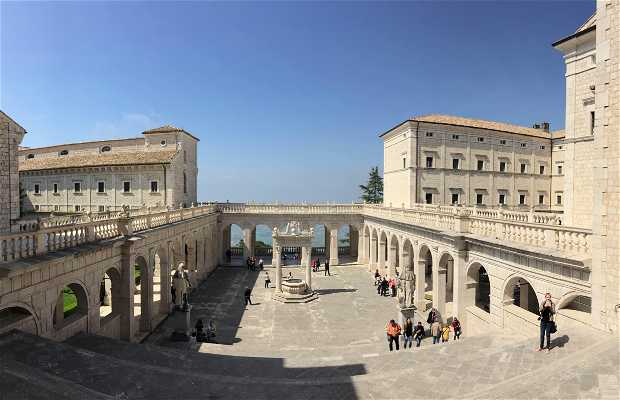Marco Guizzardi
As it was, where it was
Com'era, dov'era
Il 15 febbraio 1944, più di 200 bombardieri alleati, di cui oltre la metà quadrimotori B-17 "fortezze volanti", scaricarono un migliaio di tonnellate di bombe sul colle dove sorgeva l'Abbazia più celebre di tutta Europa, fondata da San Benedetto da Norcia nel 529. L'intento era impedire alle truppe tedesche di usare il monastero, con le sue massicce mura in grado di resistere a qualsiasi proiettile di artiglieria in uso all'epoca, come fortezza dalla quale controllare a tempo indefinito la piana di Cassino, nodo cruciale di passaggio tra Napoli, Roma, l'Abruzzo e il mare Adriatico. Di fatto le rovine dell'immenso edificio, abbandonato dai monaci, offrirono ai reparti tedeschi proprio quel rifugio che gli consentì di tenere la cima del colle per altri tre mesi, al termine dei più sanguinosi combattimenti avvenuti sulla nostra penisola nel corso della seconda guerra mondiale. L'edificio, letteralmente polverizzato dal bombardamento, era uno dei capolavori del tardo Rinascimento nell'Italia centrale. Le pitture del Giordano e del Solimena, i chiostri del Bramante e di Antonio da Sangallo scomparvero, le prime per sempre, mentre i secondi furono ricostruiti nel dopoguerra in base ai progetti originali, e al principio esemplificato dalla celebre frase attribuita all'Abate Ildefonso Rea; "com'era, dov'era". In queste foto si vedono anche quelli che appaiono come due patiti di rievocazioni storiche, o "reenactors", con le divise della fanteria americana e un paio di Jeep Willis perfettamente restaurate. Se osservate con attenzione, potete vedere che le targhe delle Jeep sono tedesche! Per dire come la storia possa riuscire a cambiare le cose col tempo.
On 15 February 1944, more than 200 Allied bombers, of which more than half of four-engine B-17 "Flying Fortresses", unloaded a thousand tons of bombs on the hill where the Abbey's most famous throughout Europe, founded by St. Benedict Norcia in 529. The intent was to prevent the German troops to use the monastery, with its massive walls able to withstand any artillery shell in use at the time, as a fortress from which to control indefinitely the plain of Cassino, a crucial passage between Naples, Rome, Abruzzo and the Adriatic Sea. In fact, the ruins of the immense building, abandoned by the monks, offered the German units that very shelter that allowed him to keep the top of the hill for another three months, at the end of the bloodiest fighting took place on the peninsula during World War II . The building was literally pulverized by the bombing, was one of the masterpieces of the late Renaissance in Central Italy. The paintings of Giordano and Solimena, the cloisters of Bramante and Antonio da Sangallo disappeared, for the first time, while the latter were rebuilt after the war, according to the original plans, and the principle exemplified by the famous phrase attributed to Abbot Ildefonso Rea , "as it was, where it was". In these photos you can also see what look like two fans of historical re-enactments, or "reenactors", with the uniforms of the American infantry and a couple of Jeep Willis perfectly restored. If you look carefully, you can see the number plates of Jeep are German! To tell how the story will be able to change things over time.



+14





